Independent Wheelchair Transfers in the Built Environment: How Transfer Setup Impacts Performance Phase 2: Final Report
Transfer Protocols
For each transfer, participants were asked to position themselves next to the platform as they normally would to prepare for a transfer. The angle of their WMD relative to the front of the platform and the x and y positions of the WMD using the grid as described above were recorded (see Figure 3). The first platform was adjusted to be level with the participant’s WMD seat height. The barricades shown in Table 2 (top picture) were adjusted to the participant’s preferred seat width. The participant transferred from their own WMD to the first platform and back to his or her device. The participant's seat width was recorded. The next five protocols (A-E) were performed in random order (Table 2). After each transfer in each protocol, any changes made to device positioning (if any), use of a transfer board, and surface(s) used for the leading hand (e.g. reaching to new surface) and trailing hand (e.g. left behind during move to new location) were recorded. For each transfer for protocols A-C, a measurement of how high and how low a participant transferred was recorded. This measurement was made from the ground to the top of the yellow seat cushion that is on the station (Table 2) when the participant was not seated on the station after they had returned to their mobility device seat; this value was recorded in inches for all transfers.
Table 2. Summary description and experimental setup for the five protocols (A-E)
|
Protocol A: Adjustable Height
|
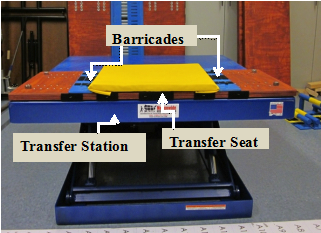 |
|
Protocol B: Adjustable Height/Grab Bars
|
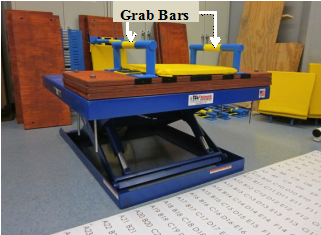 |
|
Protocol C: Adjustable Height Backrest and Grab Bar Options
|
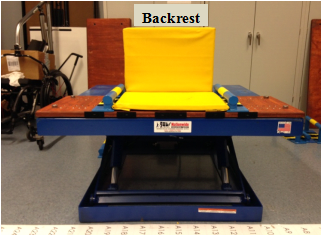 |
|
Protocol D: Adjacent Two-Step
|
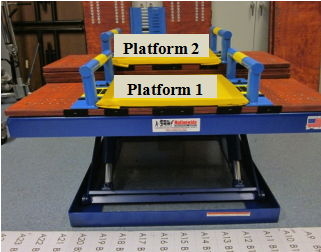 |
|
Protocol E: Two-Step with Ramp
|
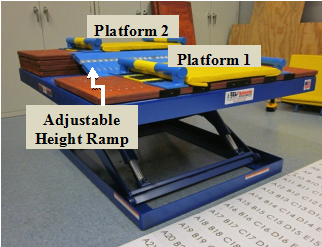 |
Protocol A: Adjustable Height
This protocol consisted of two parts: maximum height transfer and a lowest height transfer. From the Initial Setup, the scissor lift was adjusted incrementally in height so that platform 1 could be made higher or lower than the participant’s seat. The amount of vertical distance that the seat was raised/lowered each time depended on the participant's perceived and observed transfer abilities. The participant was asked to perform a transfer at each height increment until the platform was raised/lowered to a level that they no longer felt they could perform a transfer based on their own judgment or that of the study personnel. The maximum and minimum transfer heights that were attainable were recorded.
Protocol B: Adjustable Height Protocol: Grab Bar Option
This protocol consisted of three parts: level height transfer, maximum height transfer, and a lowest height transfer. The barricades from Protocol A were replaced with grab bars of two varying heights (2.75 inches and 6 inches) depending on the participant’s preference. They were also adjusted to the participant’s preferred seat width if different from the initial setup. The rest of the protocol followed the same procedure as Protocol A where the participant transferred to the first platform and back.
Protocol C: Adjustable Height: Grab Bar and Backrest Option
This protocol consisted of three parts: level height transfer, maximum height transfer, and a lowest height transfer. Protocol C used the same grab bar set up as Protocol B, but added a backrest attached behind platform 1. The participant chose one of three different height backrests (16” X 14”, 16” X 17”, and 16” X 20”). The rest of the protocol followed the same as Protocol B.
Protocol D: Adjacent Two Step Transfer
This protocol consisted of two parts: level to a higher seat and level to lower seat. From Protocol B the scissor lift was adjusted so that the first platform was set level with the participants WMD. A second platform was added to the scissor lift behind platform 1 so that they were at a 90o angle to each other. The vertical distance between platform 1 and 2 was adjusted incrementally in height: higher and lower by adding one-inch boards to either platform. The participant was asked to perform transfers to the first platform, to the second platform, back to the first platform, and then finally back to his/her WMD. The vertical distance that the second platform was raised/lowered each time depended on the participant's perceived and observed transfer abilities. The participant was asked to repeat the transfers until the second platform was raised/lowered to a level that they no longer felt they could perform a transfer based on their own judgment or that of the study personnel. The maximum and minimum vertical distances that were attainable were recorded.
Protocol E: Two Step Transfer with Ramp
This protocol consisted of two parts: level to a higher seat and level to lower seat. As with Protocol D, the first platform was set level with the participants WMD. An adjustable height ramp was attached between platform 1 and platform 2. The ramp was used to get up to and down from platform 2. The vertical distance between platform 1 and 2 was adjusted incrementally in height: higher and lower by adding one-inch boards to either platform. The ramp was capable of growing in length as the vertical distance between platforms grew. The participant was asked to perform transfers to platform 1, to platform 2 (via the ramp), back to platform 1, and then finally back to his/her WMD. The vertical distance that the second seat was raised/lowered each time depended on the participant's perceived and observed transfer abilities. The participant was asked to repeat the transfers until platform 2 was raised/lowered to a level that they no longer felt they could perform a transfer based on their own judgment or that of the study personnel. The maximum and minimum vertical distances that were attainable were recorded.

User Comments/Questions
Add Comment/Question